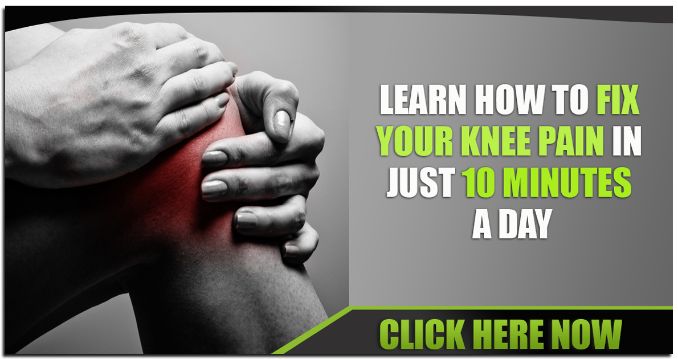Knee pain can feel like a roadblock when it comes to staying active, but it doesn’t have to be. If you’ve got weak knees or bad knees, there’s good news: you can still strengthen your legs safely and effectively. Additionally, knowing how to strengthen your legs with bad knees is essential for maintaining your mobility, reducing discomfort, and supporting your knee joints in the long term.
Moreover, by focusing on exercises that target surrounding muscles—like the hamstrings, gluteus Maximus [1], hip flexors, and the vastus medialis [2] (a key part of the thigh)—you’ll improve stability and balance without stressing your knees.
Whether you’re recovering from an injury, dealing with arthritis, or just experiencing knee pain [3], the following leg exercises are beginner-friendly and joint-safe. Additionally, you’ll keep your hips forward, your feet shoulder width apart, and your movements controlled.
Step-by-Step: Exercises to Strengthen Legs with Knee Pain
Moreover, below are 10 great exercises tailored for people with knee issues. Also, start slowly, keep your feet flat, and move with control. Additionally, equipment like resistance bands or a chair can help support your form.
1. Lunge (Bodyweight or Supported)
- Begin in an upright standing position with your feet hip-width apart.
- Maintain good alignment from your head to your hips and legs. Place your hands on your hips.
- Take a big step forward with your right leg.
- Then, engage your core muscles. Bend your left knee forward as you lower your right knee close to the floor at a 45-degree angle.
- Hold the position for a couple of seconds. Press through the front heel to return to the starting position.
- Moreover, repeat the movement on the opposite side.
Sets: 1 set of 10 reps per side.
2. Hip Hinge
- Begin in an upright standing position with your feet hip-width apart.
- Maintain good alignment with your head, shoulders, hips, and legs.
- Then, place your hands on your hips.
- Engage your core muscles. Hinge at your hips to bend your upper body forward, keeping your back straight.
- Hold the position for several deep belly breaths, in through your nose and out through your mouth.
- Moreover, return to the starting position and repeat the movements.
Sets: 1 set of 10 reps.
Alternative Exercises
Single-Leg Deadlift (Wall-Assisted)
- Begin in an upright standing position, beside a wall, with your feet hip-width apart.
- Maintain good alignment with your head, shoulders, hips, and legs.
- Then, place your hands on your hips.
- Engage your core muscles. Shift weight onto your left leg, keeping the bottom leg slightly bent.
- Extend the right leg back and then hinge forward at the hips.
- Keep your torso and extended leg in a straight line.
- Hold the position for a couple of seconds.
- Moreover, relax and repeat the movement on the opposite side.
Sets: 1 set of 10 reps.
3. Calf Raise
- Begin in an upright standing position with your feet hip-width apart.
- Maintain good alignment with your head, shoulders, hips, and legs.
- Then, engage your core muscles. Also, press the balls of your feet to lift your heels off the floor.
- Hold the position for several deep belly breaths, in through your nose and out through your mouth.
- Moreover, lower your heels to return to the starting position.
Sets: 1 set of 10 reps.
Alternative Exercise
Single Leg Calf Raise
- Begin in an upright standing position with your feet hip-width apart.
- Maintain good alignment with your head, shoulders, hips, and legs.
- Then, place your hands at your side.
- Engage your core muscles. Shift your weight onto your left leg as you slightly lift your right foot off the floor.
- Press your toes to lift your left heel off the floor. Hold the position for a couple of seconds.
- Moreover, relax and repeat the movement on the opposite side.
Sets: 1 set of 10 reps.
4. Leg Extension (Seated)
- Begin in an upright sitting position on a chair with your knees bent and feet flat on the floor.
- Maintain good alignment with your head, shoulders, and hips.
- Tighten your abdominal muscles.
- Then, lift and extend one leg forward while keeping your spine straight.
- Hold the position for a couple of seconds.
- Moreover, relax and repeat the movement on the opposite side.
Sets: 1 set of 10 reps per side.
5. Glute Bridge
- Lie on your back with your knees bent and your feet flat on the floor, allowing your upper body to relax.
- Then, place your arms at your side.
- Engage your core and glutes, then press through your heels to lift your hips.
- Maintain good alignment with your head, shoulders, hips, and knees.
- Hold this position for several deep belly breaths, in through your nose and out through your mouth.
- Moreover, relax and return to the starting position.
Bonus Exercises: 5 More for Stronger Legs and Happier Knees
Here are 5 more exercises to further illustrate how to strengthen legs with bad knees:
1. Step Ups (Low Platform)
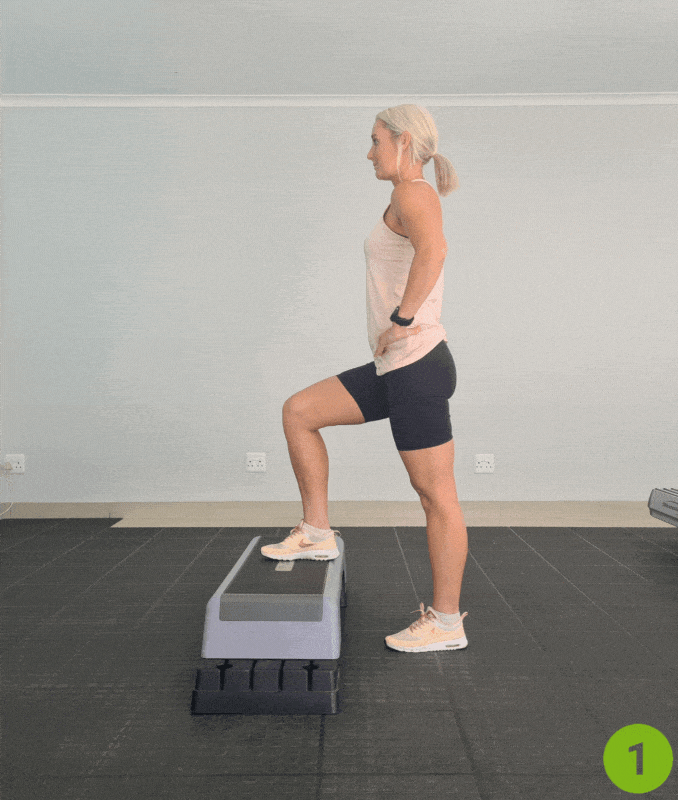
Tip: Keep hips forward and arms straight for balance.
For this exercise, use a stepper or the bottom of the stairs.
- Begin in an upright standing position in front of a stepper with your feet hip-width apart.
- Maintain good alignment with your head, shoulders, hips, and legs.
- Then, place your hands on your hips.
- Engage your core muscles. Moreover, step up with your left foot, followed by your right foot, as you do a marching movement up and down the stepper.
Sets: 1 set of 10 reps per leg.
2. Standing Hamstring Curls
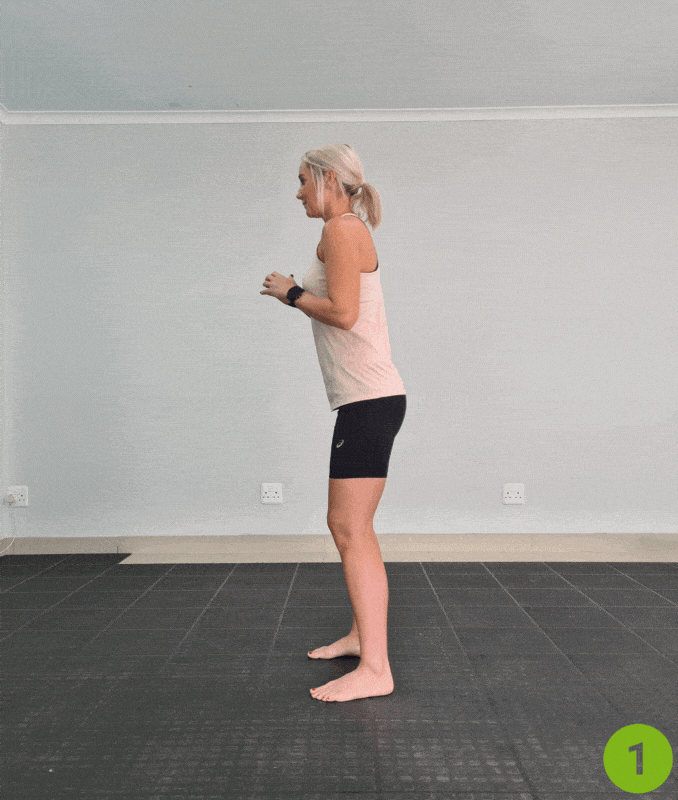
- Begin in an upright standing position with your feet hip-width apart.
- Maintain good alignment with your head, shoulders, hips, and legs.
- Then, press your hands together at chest level.
- Engage your core muscles. Bend one knee to lift your foot towards your glutes.
- Moreover, hold the position for 3 seconds, then lower your foot down to return to the starting position and repeat the movement on the opposite leg.
Sets: 1 set of 10 reps per side.
3. Wall Sit
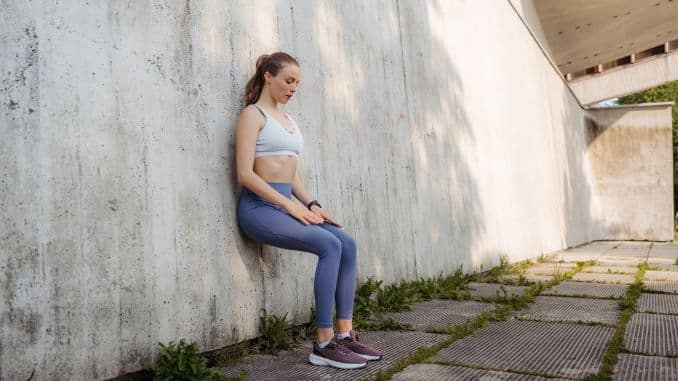
This targets all the muscles around your thighs and knee joints.
- Begin in an upright standing position with your back against the wall and your feet hip-width apart.
- Maintain good alignment with your head, shoulders, hips, and legs.
- Then, take a small step forward to increase the angle of your body.
- Engage your core muscles. Slide down until your knees are at a 90-degree angle.
- Moreover, hold the position for several deep belly breaths, in through your nose and out through your mouth.
4. Seated March
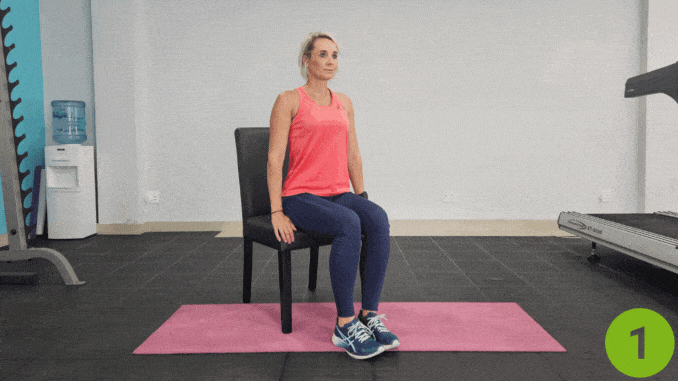
- Begin in an upright sitting position on a chair with your knees bent and feet flat on the floor.
- Maintain good alignment with your head, shoulders, and hips.
- Then, place your hands at your side.
- Tighten your abdominal muscles.
- Alternately lift your foot off the floor in a marching motion.
- Moreover, repeat the movement 15 times.
5. Resistance Band Hip Abduction
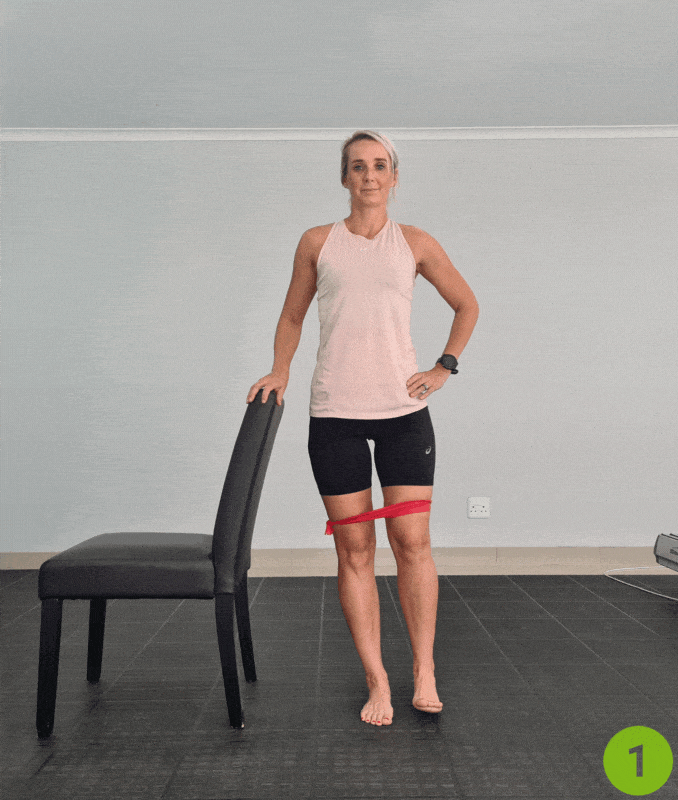
Focus: Activates the hip muscles, including the gluteus medius, which helps improve balance.
- Begin in an upright standing position beside a chair with your feet hip-width apart.
- Maintain good alignment with your head, shoulders, hips, and legs.
- Then, wrap a resistance band around your thighs just above your knees.
- Place one hand at the back of the chair for support, and put your other hand on your hip.
- Engage your core muscles. Also, lift one leg out to the side, keeping the other stable.
- Moreover, return to the starting position and repeat the movement with 10 repetitions.
- Relax and repeat the movement on the other leg.
Why These Exercises Work?
These exercises target all the muscles that stabilize and protect your knees, especially those that are often overlooked, such as the hip flexors [4], glutes, and hamstrings. Moreover, they’re designed to maintain the range of motion, reinforce your knee joints, and allow your body to move with less pain. Additionally, if you’ve been nervous about exercising due to knee pain, this is your green light to get started safely. These are great ways on how to strengthen legs with bad knees.
Dr. David Geier, Orthopedic Surgeon and Sports Medicine Specialist, Charleston, SC, emphasizes that strengthening the muscles around the knee with safe, controlled exercises is one of the most effective ways to manage and prevent knee pain, especially in patients with arthritis or prior injuries. Additionally, his advice aligns with current physical therapy best practices across the U.S.
Final Tips
- Always start with gentle movements to warm up.
- Then, focus on form, not speed.
- If needed, consult a physical therapist for guidance.
- Moreover, rest when necessary, especially if any movement causes sharp pain.
- Start with bodyweight exercises, then progress to tools like resistance bands.
Furthermore, for your complete guide to eliminating knee pain, make sure to check out Knee Pain Solved, here!
FAQ’s
What is the #1 mistake that makes bad knees worse?
Ignoring pain and doing high-impact or improper exercises (like deep squats or lunges with poor form) is also the biggest mistake that worsens bad knees. Moreover, learning how to strengthen legs with bad knees safely is essential to avoid this common pitfall. Additionally, many people make things worse by pushing through pain instead of choosing joint-friendly movements.
Can bad knees cause weak legs?
Moreover. yes. Knee pain often leads to reduced activity, which weakens the surrounding muscles, especially the quads, glutes, and hamstrings.
Should you train your legs with a bad knee?
Yes, but gently. Low-impact leg exercises that target the supporting muscles can strengthen your legs and help stabilize the knee joints. Additionally, if you’re wondering how to strengthen legs with bad knees, focus on controlled movements like seated leg lifts, wall sits, and bridges that don’t strain the joint.
Is it better to rest or stay active with knee pain?
A mix is best. Also, too much rest can cause stiffness and weakness. Moreover, gentle walking and movement can help circulation and healing—just avoid overexertion. Additionally, if you’re figuring out how to strengthen legs with bad knees, staying moderately active is key. Furthermore, low-impact movement helps maintain strength without putting excess strain on your joints.


